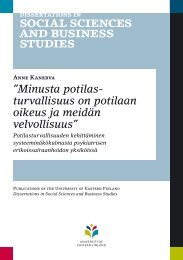urn_isbn_978-952-61-1770-6
urn_isbn_978-952-61-1770-6
urn_isbn_978-952-61-1770-6
- No tags were found...
You also want an ePaper? Increase the reach of your titles
YUMPU automatically turns print PDFs into web optimized ePapers that Google loves.
for instance, ‘emerging international consensus amongst the Contracting Statesof the Council of Europe’, 98 ‘any European consensus’, 99 ‘any clear common standardamongst the member states of the Council of Europe’, 100 ‘general trend’ 101 andalso in negative terms ‘lack of a common European approach’. 102 In addition,determining when there is sufficient consensus appears to be problematic for theECtHR. 103The ECtHR uses four different types of consensus in its reasoning: (1) consensusidentified through comparative analysis of the laws of Contracting States;(2) international consensus identified through international treaties; (3) internalconsensus in the respondent Contracting Party; and (4) expert consensus. 104Consequently, the ECtHR’s unclear definition of consensus has raised some criticism.105 Furthermore, as concluded in the ‘comparative argumentation’ article,consensus argumentation is a rather typical feature of the ECtHR but there aredifferent possibilities as to what consensus means. 106 As I further concluded:Considering the possible deficiencies and actual errors of the comparative law analysisprovided to the Court, one should be careful not to put too much weight on the similaritiesor differences of the principles or practices found in each Contracting State. 107It may be more fruitful to search for common attitudes than put too much weight onthe details in national legislative solutions. 108These creative methods of interpretation have triggered discussion as to whetherlimits should be placed on such interpretations. 109 Substantive subsidiarity hasbeen introduced to emphasise that the ECtHR should use the subsidiarity principleas guidance when interpreting the substance of Convention provisions andnot only in relation to procedural matters. 110 On the other hand, it is emphasisedthat the ECtHR’s legitimacy is based on its creative methods of interpretation andin practice this means putting human rights protection before, for example, stateconsent. 11198Lee v. The United Kingdom (2001), para. 95.99Evans v. The United Kingdom (2007), para. 54.100T v. The United Kingdom (1999), para. 72.101Nataliya Mikhaylenko v. Ukraine (2013), para. 38.102I v. The United Kingdom (2002), para.65.103See e.g. Lee v. The United Kingdom (2001) para. 96: ‘However, the Court is not persuaded that theconsensus is sufficiently concrete for it to derive any guidance as to the conduct or standards whichContracting States consider desirable in any particular situation.’104Dzehtsiarou 2011, at 548–553.105Murray 2008, at 52.106Dahlberg (‘comparative argumentation’ article), at 36.107See how the comparative law survey is provided for the ECtHR, e.g. Dzehtsiarou – Lukashevich2012, at 273–274.108Dahlberg (‘comparative argumentation’ article), at 36.109See e.g. Christoffersen 2011, at 189.110Lübbe-Wolff 2012, at 14–15.111Letsas 2013, at 126, 141; Letsas 2011, at 315–322.29




